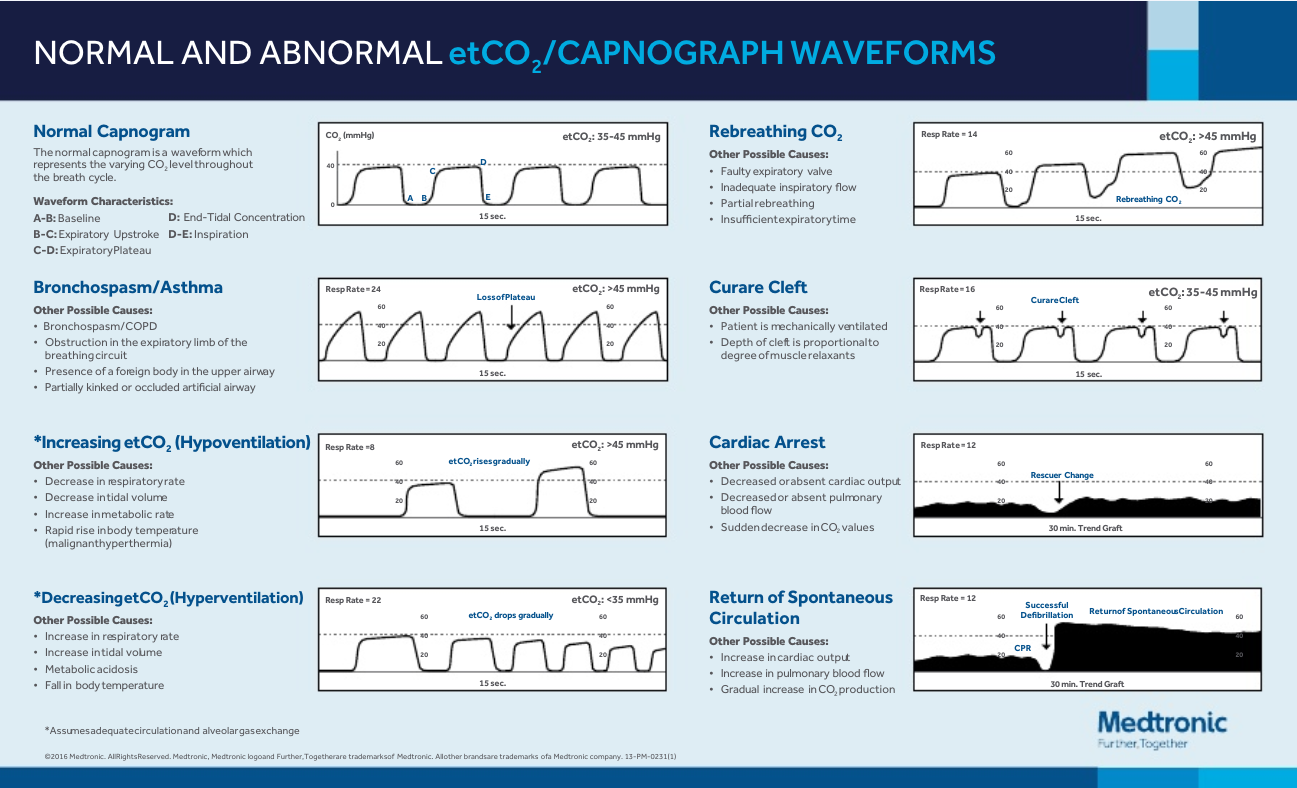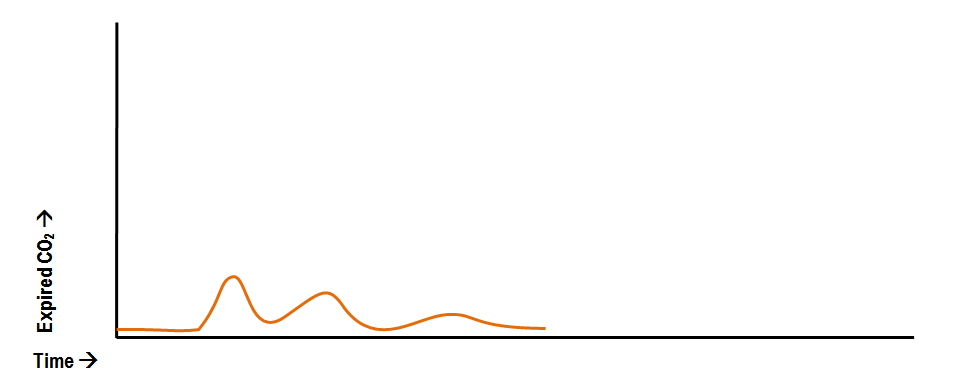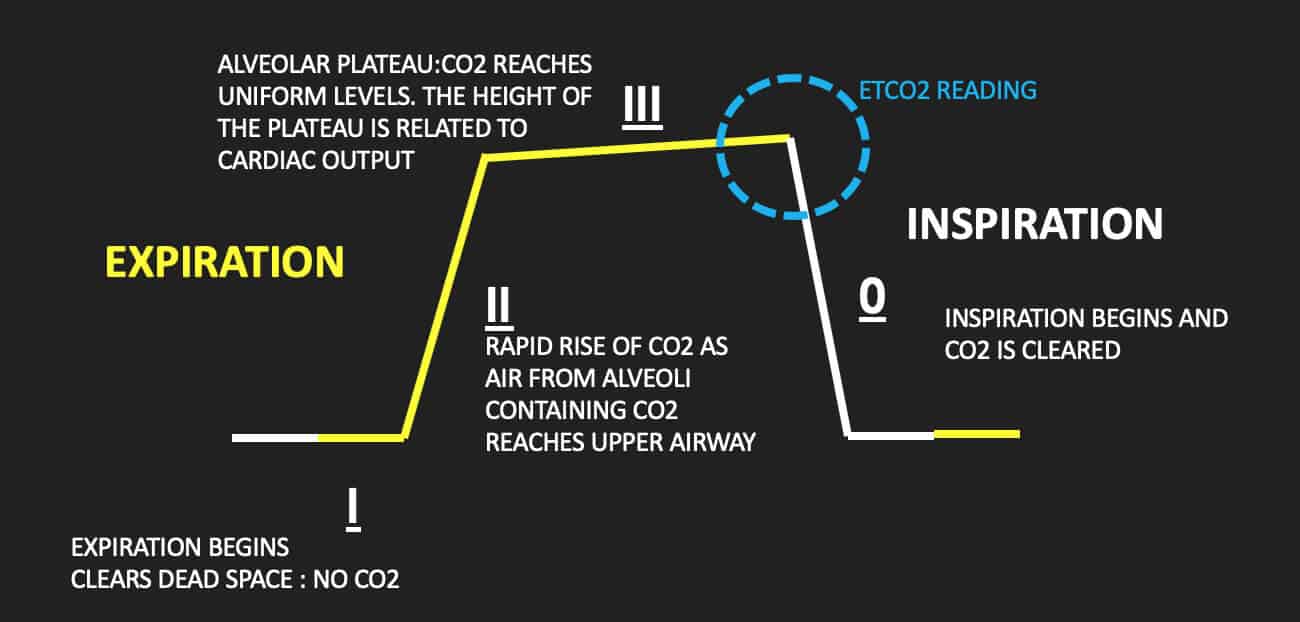normal end tidal co2 after intubation
This is t he appearance when the. End-tidal capnography or end-tidal CO2 EtCO2 monitoring is a non-invasive technique that measures the partial pressure or maximal concentration of carbon dioxide CO2 at the end of an exhaled breath.

The Impact Of Ventilation Rate On End Tidal Carbon Dioxide Level During Manual Cardiopulmonary Resuscitation Resuscitation
Rapid Sequence Intubation Figure 1-3 End-tidal CO2 detector before application.

. Despite normal EtCO 2 values. Capnography is also the most reliable indicator that an endotracheal tube is placed in the trachea after intubation. Was normal however after induction and intubation an increasing trend of the inspiratory carbon dioxide was noticed.
Negative Epigastric sounds Equal lung sounds Esophageal detector End tidal CO2 detector Secondary signs. The initial end-tidal CO 2 levels were high at about 6 kPa then decreased rapidly figure 2 confirming findings previously reported in a frozen cadaver. Although the normal range for CO2 should be between 35-45mmHg CO2 monitoring gives healthcare providers a lot more insight into what is going on with a patients condition.
Capnography can be used to assess unresponsive patients ranging from those are actively seizing to victims of chemical terrorism. Confirm ETT placement with end-tidal CO2 detector bilateral breath sounds and chest rise. No breaths to be given.
There has been increased interest in the use of capnometry in recent years. Capnograph is an indispensable tool for monitoring metabolic and respiratory function. ETCO2 emergency department monitoring and critical.
Turn the respiratory rate up to 12 BPM This ensures the patient is still blowing off CO2. Immediately after intubation etCO2 can help adjust the ventilator settings. Wait 45-60 seconds after drugs are flushed then proceed with intubation 12.
The presence of a normal waveform denotes a patent airway and spontaneous breathing. 4 etCO2 target can be achieved with a relatively normal minute ventilation eg. Sidestream ETCO 2 SSETCO 2 might be a non-invasive rapid and reliable predictor of.
The waveform is called capnograph and shows how much CO 2 is present at each phase of the respiratory cycle. The purpose of our study was to determine whether ETCO2 measurement could distinguish tracheal from esophageal tube. The use of quantitative end-tidal capnometry to avoid inadvertent severe hyperventilation in patients with head injury after paramedic rapid sequence intubation.
A semiquantitative colorimetric FEF end-tidal CO2 detector Fenem Inc. A prospective clinical trial was conducted at a level I trauma center to assess the efficacy of end-tidal carbon dioxide CO2 detection in four groups of patients requiring emergency intubation because of cardiac arrest major trauma respiratory failure or the need for airway protection. The box on the lower right-hand side of the graph depicts time to recovery from succinylcholine which in almost all cases exceeds safe apnea time.
Waveform and end -tidal carbon dioxide EtCO2 values. Measurement of end-tidal carbon dioxide ETCO2 has been used to detect accidental esophageal tube placement in noncardiac arrest situations. 423 20 mmHg versus 34 255 mmHg.
A low end-tidal CO2 may indicate poor perfusion hypovolemia or sepsis. The amount of CO2 at the end of exhalation or end-tidal CO2 ETCO2 is normally 35-45 mm HG. A novel observation was that the level of CO 2 rose again although at low levels when CPR was started presumably due to effective circulation.
The indicator is purple which indicates failure to detect CO2. If no CO2 present and remainder of exam does not confirm proper tube. Use End-Tidal Capnography to see what CO2 your patient is at You want to shoot for this number or lower to ensure your patient is still blowing off CO2 Induction of Patient with RSI Meds Give a good jaw thrust to ensure the airway is open.
End-tidal CO2 measurement in the detection of esophageal intubation during cardiac arrest. On inspection of the sodalime canister we observed that the sodalime was filled till the. 428 153 mmHg versus 323 141 mmHg.
End tidal CO 2 monitoring is represented as a number and a graph on a monitor. When CO2 diffuses out of the lungs into the exhaled air a device called a capnometer. Changes in the shape of the capnogram are diagnostic of disease conditions while changes in end-tidal CO 2 EtCO 2 the maximum CO 2 concentration at the end of each tidal breath can be used to assess disease severity and response to treatment.
End tidal normally 2-5 mmHg lower than arterial Comparing Arterial and End-tidal CO2 Review of Airway Confirmation Visualization Auscultation. Results The median time for initial detection of ETCO 2 following intubation was 37 range 044 s which was significantly shorter than the median time for ETCO 2 to reach 4 mm Hg 53 range 0727 s and to reach 15 mm Hg 81 range 0827. This was followed by an increase in end tidal carbon dioxide after a few minutes.
Misting increased SaO2 Types of End-Tidal CO2 Qualitative Yes or No. More Than Just a Number. Changes in end-tidal carbon dioxide and volumetric carbon dioxide as predictors of volume responsiveness in hemodynamically unstable patients.
On the other hand a high CO2 reading may indicate airway narrowing. Patients arriving in the emergency department ED need rapid and reliable evaluation of their respiratory status. In this study the aim was to review the applications of end-tidal carbon dioxide ETCO2 monitoring in emergency department multiple databases were comprehensively searched with combination of following keywords.
Seventy-six patients were excluded. Norm al EtCO2 levels 46 to 60 kPa signify adequate perfusion. Graphically this difference in ROSC vs non-ROSC PetCO2 for both groups appeared to be even greater at ten minutes.
2 to near normal normal EtCO 2 35-45 mmHg represents marked increase of CO 2 delivery to lungs suggesting ROSC If patient develops an organized rhythm after VFVTasystole check EtCO 2 to see if ROSC has occurred CONFIRM PLACEMENT OF ETT After intubation if ETCO 2 10mm Hg tube in trachea. From January 2014 to December 2019 a total of 181 patients were admitted to our trauma center by HEMS after TBI and intubation. Mainstream end tidal carbon dioxide ETCO 2 is one of the methods used for this purpose during general anaesthesia of intubated patients in the operating theatre.
Main outcome measures The time following intubation for ETCO 2 levels to be initially detected and to reach 4 mm Hg and 15 mm Hg. During cardiopulmonary resuscitation CPR the partial pressure of end-tidal carbon dioxide PetCO 2 correlates with cardiac output and consequently it has a prognostic value in CPRThis study was undertaken to compare the initial PetCO 2 and the PetCO 2 after 1 min. The normal values are 5-6 CO2 which is equivalent to 35-45 mmHg.
Confirm absent sounds over epigastrium 13. In mmHg the PetCO2 values for those with and without ROSC after five minutes of CPR was. The number is called capnometry which is the partial pressure of CO 2 detected at the end of exhalation ranging between 35 - 45 mm Hg or 40 57 kPa.

Normal And Abnormal Capnography Waveforms Infographic Capnoacademy Capnoacademy

Basic Capnography Interpretation Nuem Blog

Atls10 Post Test 40 Mcq With Answers Highlighted Breath Sounds Answers Mcq

Waveform Capnography In The Intubated Patient Emcrit Project

Abnormal Capnography Waveforms And Their Interpretation Deranged Physiology

Waveform Capnography In The Intubated Patient Emcrit Project

Quantitative Waveform Capnography Acls Medical Training

Capnography Nursing Procedures Icu Nursing Nursing School Studying

Waveform Capnography In The Intubated Patient Emcrit Project
End Tidal Co2 Monitoring In The Pre Hospital Environment More Than Just Endotracheal Tube Placement Confirmation Journal Of Paramedic Practice

Reversible Causes Of Low Etco2 In Cpr Criticalcarenow

3 Waveform Capnography Showing Changes In The End Tidal Carbon Dioxide Download Scientific Diagram

Waveform Capnography In The Intubated Patient Emcrit Project

Waveform Capnography In The Intubated Patient Emcrit Project

End Tidal Co2 Respiratory Therapy Tidal Co2

Potential Applications Of Capnography In The Prehospital Setting Journal Of Paramedic Practice

Waveform Capnography In The Intubated Patient Emcrit Project

What S In A Wave Form Utilizing End Tidal Capnography For More Than Intubation Confirmation Criticalcarenow
